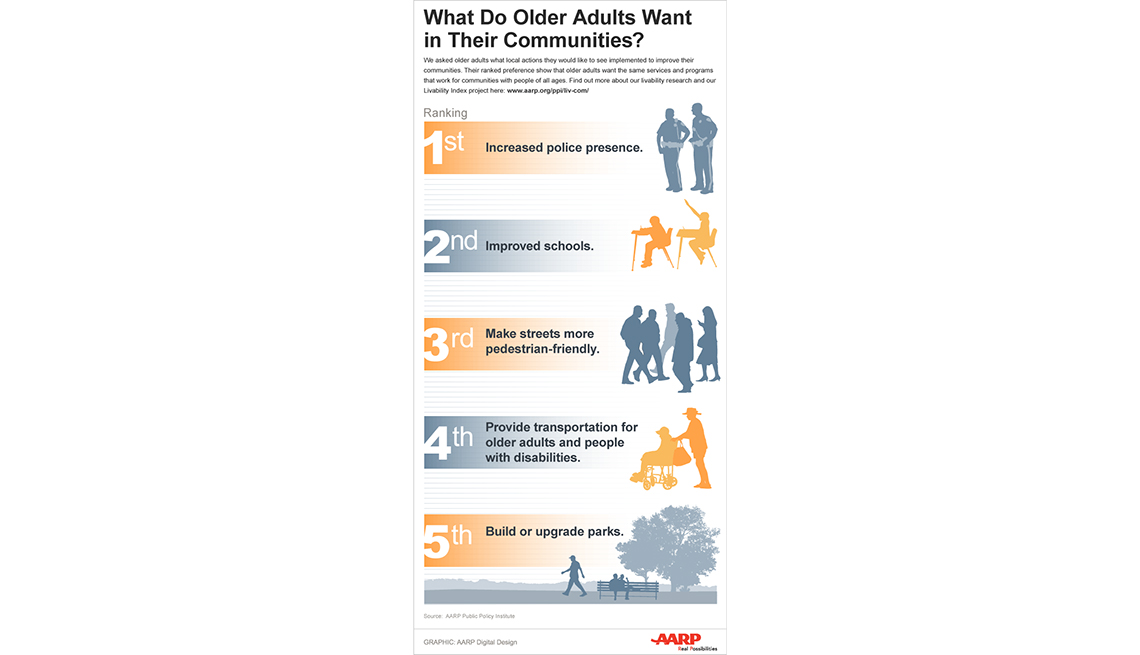What is livable? Community preferences of older adults
What is livable? Community preferences of older adults"
- Select a language for the TTS:
- UK English Female
- UK English Male
- US English Female
- US English Male
- Australian Female
- Australian Male
- Language selected: (auto detect) - EN
Play all audios:
This report explores the meaning of livability and describes lessons learned by PPI as part of its work to measure community livability and quantify the degree to which a community has the
elements that are necessary to meet individual needs regardless of age, income, physical ability, ethnicity, and other factors. This work also includes findings from an individual community
preference survey of older adults. LESSONS LEARNED: 1. Individual definitions of “livability” can include issue areas that may or may not be addressed by public policy. 2. People and
communities have differing perspectives: one type of community does not fit all. 3. Perceptions of a livable community are made when choosing housing, and they may not change as the person
ages, unless a major life change forces a new perspective. KEY FINDINGS: General findings about the population ages 50 and older: * Most of the 50+ population want to age in their homes and
communities. * The importance of proximity to community elements varies greatly. HOUSEHOLD INCOME INFLUENCES THOUGHTS ABOUT THE IMPORTANCE OF LOCAL GOVERNMENT SPENDING PRIORITIES: *
Increasing police presence and improving schools are key government services for most of the older adult population, but different groups rank other local actions in widely varying ways. *
Most non-drivers say they live in communities that are already pedestrian-friendly. FINDINGS FOR SUBGROUPS WITHIN THE POPULATION AGES 50 AND OLDER: * There are modest racial and ethnic
differences in priorities, but there are great differences in the places where different groups connect with community members. * Personal safety is more of a concern for family caregivers,
for people with disabilities, for nondrivers, and for people with lower incomes. * Most nondrivers say they live in communities that are already pedestrian-friendly. * Specialized
transportation and local government decision-making processes are important issues for people with disabilities and for family caregivers. * For renters, funding for affordable housing
programs is the most important local government investment.
Trending News
Hubert | Terra NovaNotePour l’expérimentation de salles de consommation superviséeSoutenue par des acteurs de premier plan, la mise en plac...
Mind matters: placebo enhances reward learning in parkinson's diseaseABSTRACT Expectations have a powerful influence on how we experience the world. Neurobiological and computational models...
Must-know foodie tips on shopping, prepping and staying fitDEAN ORNISH, M.D., 70, LIFESTYLE MEDICINE SPECIALIST AND BEST-SELLING AUTHOR Ornish will always be known as the man who ...
Most Powerful Women in BusinessSign InHomeRankingsFortune 500 IndiaMost Powerful WomenThe Next 500Forty Under FortyBest B-SchoolsMNC 500ProfilesCompani...
Javascript support required...
Latests News
What is livable? Community preferences of older adultsThis report explores the meaning of livability and describes lessons learned by PPI as part of its work to measure commu...
Time to excel in orthodontics | British Dental JournalThis year, 3M Oral Care has made rising up to new levels of excellence in orthodontics easier than ever before - E-xcell...
Raiders : no ray of hope with next game in kingdomeAfter seven consecutive defeats, and five straight in which they have trailed by double figures, you might be tempted to...
The Longest Jump - Los Angeles TimesBob Beamons’ leap of 29 feet 2 1/2 inches at the 1968 Olympics was considered by many a fluke in the thin air of Mexico ...
Interaction of hydrocortisone and illness severity on head growth in cohort of elbw infantsABSTRACT BACKGROUND Extremely low birth weight (ELBW) infants comprise a fragile population at risk for neurodevelopment...
